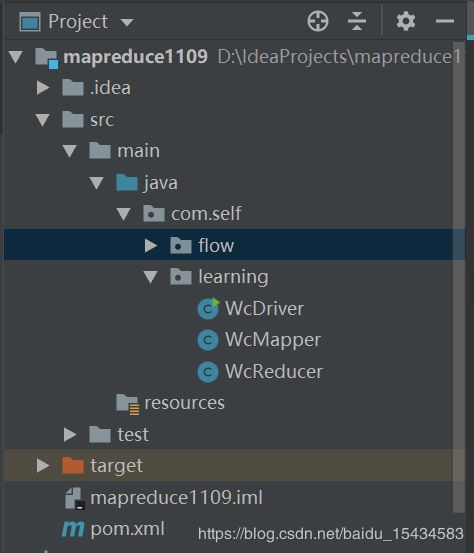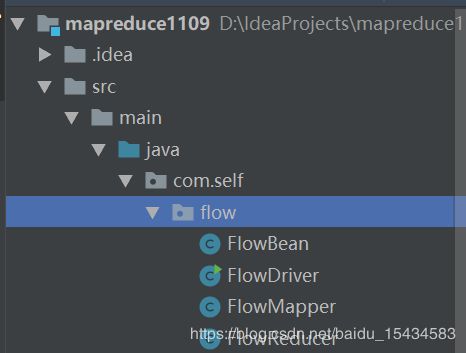MapReduce编程规范-wordcount实战 && hadoop序列化例子
一、程序分为3部分:Mapper,Reducer,Driver
通过java实现map_reduce版本的word_count例子
1、Mapper阶段
(1)用户自定义的Mapper要继承 org.apache.hadoop.mapreduce.Mapper类
(2)Mapper的输入数据是KV对的形式
(3)Mapper中的业务逻辑在map()方法中实现
(4)Mapper的输出数据是KV对的形式
(5)map()方法(MapTask进程)对每一个
2、Reducer阶段
(1)用户自定义的Reducer要继承 org.apache.hadoop.mapreduce.Reducer类
(2)Reducer的输入类型对应Mapper的输出类型;也是KV对的形式
(3)Reducer中的业务逻辑在reduce()方法中实现
(4)ReduceTask进程对每一组相同的
项目的层级结构如下
创建三个java类;分别是WcDriver,WcMapper,WcReducer
1.创建 WcMapper.class 内容如下
package com.self.learning;
import org.apache.hadoop.io.IntWritable;
import org.apache.hadoop.io.Text;
import org.apache.hadoop.mapreduce.Mapper;
import org.apache.hadoop.io.LongWritable;
import java.io.IOException;
//输入类型 <每一行输入文件的偏移量offset,行数据line> 对应的类型是LongWritable, Text
//输出类型 text,IntWritable
public class WcMapper extends Mapper{
private Text word = new Text();
private IntWritable one = new IntWritable(1);
@Override
protected void map(LongWritable key, Text value, Context context) throws IOException, InterruptedException {
//拿到一行数据
String line = value.toString();
//按空格切分数据
String[]words = line.split(" ");
//遍历数组,把单词变成(word,1)的形式交给框架
for(String w:words){
//context.write(new Text(word),new IntWritable(1)); //大量生成新的对象,会促使频繁的调用垃圾回收
this.word.set(w);
context.write(this.word,this.one);
}
}
} 2.创建WcReducer.class
package com.self.learning;
import org.apache.hadoop.io.IntWritable;
import org.apache.hadoop.mapreduce.Reducer;
import org.apache.hadoop.io.Text;
import java.io.IOException;
//map任务输出的数据输入到reduce
//因此reduce的输入(word,1) Text, IntWritable
//reduce的输出泛型 是(word,n) Text, IntWritable
public class WcReducer extends Reducer {
private IntWritable total = new IntWritable();
@Override
//此时,是按照相同的key为一组的,很多个value;所以values是一个可迭代的对象
protected void reduce(Text key, Iterable values, Context context) throws IOException, InterruptedException {
//对相同key的value进行累加操作
int sum=0;
for(IntWritable value:values){
sum+=value.get();
}
//包装结果并输出
total.set(sum);
context.write(key,this.total);
}
}
3.创建WcDriver.class
package com.self.learning;
import org.apache.hadoop.conf.Configuration;
import org.apache.hadoop.fs.Path;
import org.apache.hadoop.io.IntWritable;
import org.apache.hadoop.io.Text;
import org.apache.hadoop.mapreduce.Job;
import org.apache.hadoop.mapreduce.lib.input.FileInputFormat;
import org.apache.hadoop.mapreduce.lib.output.FileOutputFormat;
import java.io.IOException;
public class WcDriver {
public static void main(String []args) throws IOException ,ClassNotFoundException,InterruptedException{
//1.获取job实例
Job job = Job.getInstance(new Configuration());
//2.设置类路径classpath
job.setJarByClass(WcDriver.class);
//3.设置mapper和reducer
job.setMapperClass(WcMapper.class);
job.setReducerClass(WcReducer.class);
//4.设置mapper和reducer的输出类型
job.setMapOutputKeyClass(Text.class);
job.setMapOutputValueClass(IntWritable.class);
job.setOutputKeyClass(Text.class);
job.setOutputValueClass(IntWritable.class);
//5.设置输入输出数据源
FileInputFormat.setInputPaths(job,new Path(args[0]));
FileOutputFormat.setOutputPath(job,new Path(args[1]));
boolean b = job.waitForCompletion(true);
System.exit(b? 0:1);
}
}
二、Hadoop序列化
什么是序列化?
序列化就是把内存的对象,转换成字节序列(或其他数据传输协议)以便于存储到磁盘(持久化)和网络传输。
反序列化就是将收到的字节序列或者磁盘的持久化数据,转换成内存中的对象
为什么没有用Java的序列化?
Java的序列化是一个重量级的框架(Serializable),一个对象被序列化后,会附带很多额外的信息(各种校验信息,Header,继承体系等),不便于在网络中高效传输。所以hadoop自己开发了一套序列化机制(Writable)
Hadoop序列化的特点:
- 紧凑:高效使用存储空间
- 快速:读写数据的额外开销小
- 可扩展:随着通信协议的升级而可升级
- 互操作:支持多语言的交互
假设我们有一个需求是获取同一个手机号用户的总上行流量,总下行流量和总流量
数据文件如下(特此声明:数据并非真实数据):文件以空格隔开,第二列是用户手机号,倒数第三列是上行记录,倒数第二列是下行记录
这种情况下,我们的map的输出 key应该为手机号,value为(上行,下行,上下行的综合)这样的一个对象
其中FlowBean类里实现了,我们自定义的数据对象类型
1、创建FlowBean.class
package com.self.flow;
import org.apache.hadoop.io.Writable;
import java.io.DataInput;
import java.io.DataOutput;
import java.io.IOException;
public class FlowBean implements Writable { //需要实现hadoop的序列化Writable
private long upFlow;
private long downFlow;
private long sumFlow;
public FlowBean() { //构造函数
}
@Override
public String toString() {
return upFlow+"\t"+downFlow+"\t"+sumFlow;
}
public void set(long upFlow, long downFlow){ //实现一个set函数
this.upFlow = upFlow;
this.downFlow = downFlow;
this.sumFlow = upFlow + downFlow;
}
public long getUpFlow() {
return upFlow;
}
public void setUpFlow(long upFlow) {
this.upFlow = upFlow;
}
public long getDownFlow() {
return downFlow;
}
public void setDownFlow(long downFlow) {
this.downFlow = downFlow;
}
//注意:序列化和反序列化的变量顺序一定要保证是一样的
/**
*序列化方法
* @param dataOutput
* @throws IOException**/
public void write(DataOutput dataOutput) throws IOException {
dataOutput.writeLong(upFlow);
dataOutput.writeLong(downFlow);
dataOutput.writeLong(sumFlow);
}
/***
* 反序列化
* @param dataInput
* @throws IOException**/
public void readFields(DataInput dataInput) throws IOException {
upFlow = dataInput.readLong();
downFlow = dataInput.readLong();
sumFlow = dataInput.readLong();
}
}
2、创建FlowMapper.class
package com.self.flow;
import org.apache.hadoop.io.LongWritable;
import org.apache.hadoop.io.Text;
import org.apache.hadoop.mapreduce.Mapper;
import java.io.IOException;
import java.util.List;
public class FlowMapper extends Mapper {
private Text phone=new Text();
private FlowBean flow = new FlowBean();
@Override
protected void map(LongWritable key, Text value, Context context) throws IOException, InterruptedException {
String []fields = value.toString().split(" ");
phone.set(fields[1]);
long upFlow = Long.parseLong(fields[fields.length-3]);
long downFlow = Long.parseLong(fields[fields.length-2]);
flow.set(upFlow,downFlow);
context.write(phone,flow);
}
}
3.创建FlowReducer.class
package com.self.flow;
import org.apache.hadoop.io.Text;
import org.apache.hadoop.mapreduce.Reducer;
import java.io.IOException;
public class FlowReducer extends Reducer {
private FlowBean sumFlow = new FlowBean();
@Override
protected void reduce(Text key, Iterable values, Context context) throws IOException, InterruptedException {
long sumUpFlow = 0;
long sumDownFlow = 0;
for(FlowBean value:values){
sumUpFlow +=value.getUpFlow();
sumDownFlow += value.getDownFlow();
}
sumFlow.set(sumUpFlow,sumDownFlow);
context.write(key,sumFlow);
}
}
4、创建FlowDriver.class
package com.self.flow;
import org.apache.hadoop.conf.Configuration;
import org.apache.hadoop.fs.Path;
import org.apache.hadoop.io.Text;
import org.apache.hadoop.mapreduce.Job;
import org.apache.hadoop.mapreduce.lib.input.FileInputFormat;
import org.apache.hadoop.mapreduce.lib.output.FileOutputFormat;
import java.io.IOException;
public class FlowDriver {
public static void main(String[] args) throws IOException, ClassNotFoundException, InterruptedException {
Job job = Job.getInstance(new Configuration());
job.setJarByClass(FlowDriver.class);
job.setMapperClass(FlowMapper.class);
job.setReducerClass(FlowReducer.class);
job.setMapOutputKeyClass(Text.class);
job.setMapOutputValueClass(FlowBean.class);
job.setOutputKeyClass(Text.class);
job.setOutputValueClass(FlowBean.class);
FileInputFormat.setInputPaths(job,new Path(args[0]));
FileOutputFormat.setOutputPath(job,new Path(args[1]));
boolean b = job.waitForCompletion(true);
System.exit(b? 0:1);
}
}


